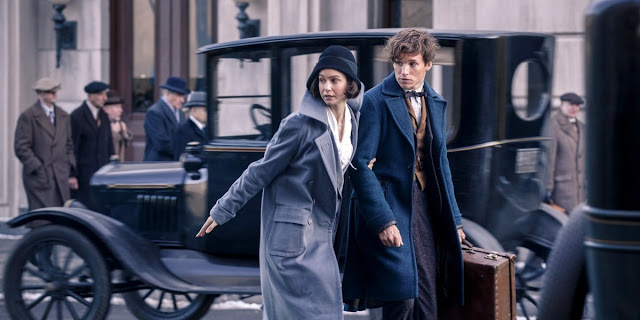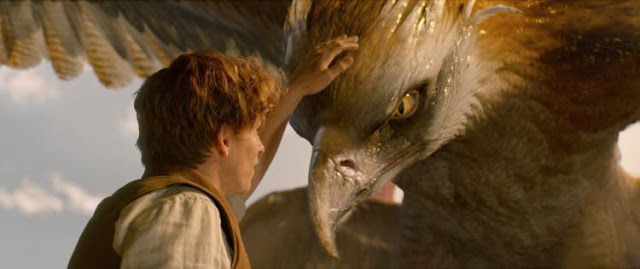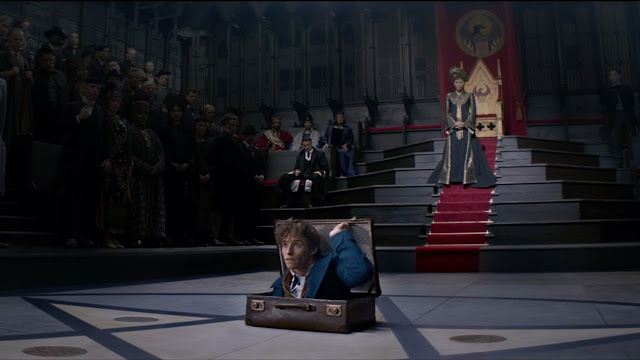Standing in the middle of a verdant forest where his bedroom used to be, gawking upward at a supple thunderbird the size of a small whale, Jacob Kowalski confirms that he is not in fact dreaming. “I don’t have the brains to make this up,” he admits. But J.K. Rowling does. The Harry Potter author has a limitless imagination, and the mega success of her seven novels (and eight corresponding movies) derived from her peerless ability to fuse her gift for make-believe with traditional, stalwart stories about bravery, sacrifice, and the coming of age. Among the innumerable virtues of her opus was its deceptive discipline; though the books grew progressively longer, they never felt unwieldy, and Rowling stuck to her promise of concluding Harry’s tale with the seventh volume. (Contrast this with George R.R. Martin’s Game of Thrones series, where the writer once wrote a book so long that he had to cleave it in two, and where disgruntled readers—not that I have anyone in mind—are currently gnashing their teeth awaiting the sixth installment.)
Yet while the 2007 release of The Deathly Hallows may have marked the end of Harry’s personal saga—a journey that remains inviolate, untarnished by special editions or alternate versions—his creator has started to gently expand the world he occupies. This began this past summer, when the London stage debuted Harry Potter and the Cursed Child, a play based on a story that Rowling co-wrote and that centers on Albus, Harry’s troubled teenage son. And it continues now with Fantastic Beasts and Where to Find Them, Rowling’s first foray into screenwriting. You might consider the very existence of this movie (and the four that are rumored to follow) to be a vulgar cash-grab, a mercenary move from a selfish artist intent on squeezing every possible penny from her adoring fan base. I prefer to view it as a fascinating opportunity. Because Fantastic Beasts takes place in the land of Potter but is not based in any substantive way on her prior work (technically, the title stems from one of Harry’s school textbooks), Rowling has given herself the chance to conceive something both comfortingly familiar and wholly original. She can return to her beloved magical universe and, at the same time, start from scratch.
Therein lies the potential. The result, I am happy and sad to say, is decidedly mixed. Fantastic Beasts once again showcases Rowling’s ability to build compelling worlds, and to smuggle valuable life lessons inside bewitching tales of fantasy. It also confirms director David Yates’ underappreciated skill at translating Rowling’s prose into flavorful pictorial beauty. But despite Rowling’s talent with mythology and Yates’ facility with CGI, Fantastic Beasts is something of a sputterer. It oscillates between moments of breathtaking wonder and stretches of leaden plotting and clunky dialogue. It casts spells but struggles to sustain them.
Set in 1926 (a good 65 years before Harry’s arrival at Hogwarts), Fantastic Beasts opens with a scene that could have been yanked straight outta Brooklyn, as a Briton nervously passes through customs at Ellis Island. A hunched, squirrelly fellow, he carries with him a highly suspicious suitcase whose animate contents are hardly a mystery to the audience. The man is Newt Scamander (Eddie Redmayne), a diffident wizard who whispers soothingly to the critters in his case but whose tranquility changes to panic when one of his wards—an impossibly cute platypus-like waddler called a niffler—escapes and wreaks havoc in a Manhattan bank. Desperate to recapture the creature before it’s detected, Newt collides with the aforementioned Jacob (Dan Fogler), a downtrodden baker who witnesses Newt’s spellwork with dumbfounded incredulity. Jacob is a No-Maj—better known to Newt, and to Potter fans, as a Muggle—and because a No-Maj seeing magic is a no-no, his presence creates a new problem for Newt. In addition to relocating several other animals who have absconded, he must wipe Jacob’s memory or risk violating the age-old secrecy laws that separate wizards and witches from their human counterparts.
That’s a lot to worry about, but Fantastic Beasts is just getting started. Over the film’s first half-hour, Rowling’s script jumps, somewhat clumsily, across a variety of seemingly disconnected subplots. In the primary thread, Newt and Jacob find themselves shepherded to the home of Tina Goldstein (Katherine Waterston), a disgraced witch who lives with her mind-reading sister, Queenie (the singer Alison Sudol); hoping to improve her station at “MACUSA” (aka the Magical Congress of the United States of America), Tina resolves to help Newt recover his missing creatures before they do significant damage. Meanwhile, the magical politicians at MACUSA—including President Seraphina Picquery (Carmen Ejogo) and her chief lieutenant, Percival Graves (Colin Farrell, wearing the black coat well)—are investigating bizarre disturbances in the city that appear to be caused by a berserk beast. Meanwhile, Graves regularly meets in secret with Credence (Ezra Miller), a gaunt orphan who seems to be protecting someone and whose adoptive mother, Mary Lou (Samantha Morton), is a demagogue who preaches to alarmed crowds about a sinister, unseen coven of magicians lurking in the city. And MEANWHILE, Jon Voight pops up as a media magnate whose elder son is a rising political star and whose younger son feels neglected—you can’t forget about them.
Except, really, you can. The busyness of Fantastic Beasts’ opening act seems designed to dilute each segment’s obvious flaws, but it only underscores the movie’s wildly inconsistent tone. Where the mystery facets of Rowling’s script suggest an ominous thriller (if not an especially coherent one), the antics at the Goldstein household play like a dubious fish-out-of-water comedy, with Jacob in a state of perpetual befuddlement. Of course, there’s no harm in a film mingling light elements with dark ones—the Harry Potter movies were always underrated for their dry humor, especially whenever Rupert Grint, Emma Watson, or Alan Rickman were on screen—but the dialogue involving the four leads is oddly strained. Rowling is a very funny writer, but here she seems at a loss how to integrate her bumbling No-Maj into her vibrant magical universe.
Eventually, she figures it out: Just dump him smack into the middle of it. Following an exceptionally awkward dinner, Newt opens his suitcase and somehow disappears inside it, beckoning Jacob to join him. And here, Fantastic Beasts swiftly realizes the full cinematic potential of Rowling’s fantastical conceit. That suitcase houses an expansive alternate reality, one where Newt’s creatures are allowed to roam free. And in briefly exploring the variety and ingenuity of Newt’s menagerie, Yates finally allows the movie to take wing. The irony is that the film’s grandest sequence is also its most peaceful; rather than bombard you with his spectacle, Yates generously brings you closer to it, inviting you to stare upward like Jacob with awe. The beasts truly are fantastic—so are the special effects, which give each fake creature a realistically tactile dimension.
This extended scene, which rivals a similar interlude in The BFG for phantasmagorical splendor, is the movie’s richest moment, but it is hardly its only instance of computer-generated savvy. Yates, who helmed the final four Harry Potter films (each of which landed in this critic’s top 10 list for their respective years), has an instinctive understanding of Rowling’s imagination, and he recognizes that her fanciful inventions are often best placed in the background. And so, even ignoring its perfunctory use of 3-D, Fantastic Beasts is peppered with lovely bits of casual, effects-driven magic: a self-cooking dinner, a dress sewing itself back together, two pieces of rhinoceros-shaped origami ripping one another to shreds (recalling Kubo and the Two Strings), complex clocks that tell mood rather than time. Nor is Yates’ flair limited to mere whimsy. He can make magic terrifying as well as awe-inspiring, and a late scene here—in which Newt and Tina confront a glossy pool of black liquid that seems to function as a graveyard of memories—thrums with the threat of death.
The movie’s technical prowess and visual wit would feel empty if they didn’t serve compelling characters, and for a time, they don’t. But as Fantastic Beasts progresses, it acquires a curious, melancholic hue that helps distinguish it from its filmic predecessors. True, it explores the same themes that Rowling previously articulated so adroitly: the need for tolerance and understanding; the toxicity of fear of the unknown; the way that fear can feed support for fascism. (If you doubt the relevance of Rowling’s allegory, consider: The day after this movie hit theaters, this happened.) But when it comes to protagonists, Fantastic Beasts is altogether different. Where Harry Potter was known throughout the wizarding world (“The Boy Who Lived!”) and wrestled with the pressures of fame, Newt Scamander is something of a misfit, a weird laughingstock who is mocked and discredited. (There are whisperings of his unseen brother, a beloved war hero; that relationship that will inevitably be fleshed out in the sequels.) And while Harry was generally a personable teenager—prone to spasms of anger, but otherwise friendly and eager for human connection—Newt appears to be more invested in animals than people.
This oddness makes Newt interesting. (It also makes the teasing of a possible future romance between him and Tina feel forced; in contrast, the star-crossed love that blooms between Jacob and Queenie is undeniably sweet, even if it is also lumpy and corny.) Yet Fantastic Beasts doesn’t quite know what to do with him, or itself. Rowling reaffirms her knack for devising cleverly disguised twists—keep your eyes on Credence’s younger sister, who recites anti-witch propaganda while playing hopscotch and who seems awfully shady—but her story builds to a finale that is fundamentally unsatisfying. Part of this may stem from some lackluster action sequences; an ill-conceived, childish scene in Central Park involving an aroused quasi-rhino is unworthy of this franchise, while the climax in a subway tunnel features entirely too much weightless wand-waving (“Accio! Obliviate!”). That will likely go double for non-readers: On the whole, familiarity with Potter lore isn’t essential to appreciate this film, but it certainly helps—not just to pick up on the significance of dropped names (Grindelwald! Lestrange!), but to intuitively comprehend the combatants’ spellwork.
The larger problem, though, is the lack of a proper villain. In a rare piece of miscalculation, Rowling has concocted a malevolent force called an Obscurus, which is essentially ever-shifting plumes of menacing smoke meant to embody our darkest impulses. It’s an intriguing idea, but it’s ultimately theoretical and even a little cowardly; evil tends to look and feel scarier when it comes in the form of a human face. The movie’s denouement does promise the emergence of a bona fide heavy (played by a bona fide American movie star) in its sequels, but for purposes of this installment, the stakes feel diminished.
Maybe that’s the point: Fantastic Beasts and Where to Find Them represents the beginning of a new franchise, not its culmination. And there’s certainly enough here to make me excited about the future. Still, it’s disappointing that Rowling and Yates needed to use this movie as a springboard, rather than delivering a fully realized fantasy adventure right out of the gate. There remains a good deal of magic to be found in Rowling’s writing and Yates’ filmmaking, but while Fantastic Beasts reminds you of their genius, it fails to fully capitalize on it. Call it a Half-Maj.
Jeremy Beck is the editor-in-chief of MovieManifesto. He watches more movies and television than he probably should.




